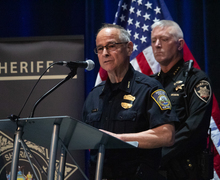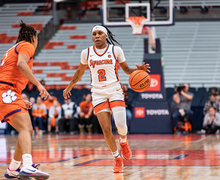Charity partners with Connective Corridor to raise funds, help beautify downtown
A philanthropic startup and the Connective Corridor are harnessing the power of social media to get students to invest in Syracuse’s beautification.
The Connective Corridor, a $42.5 million initiative to restore Syracuse to a resilient center of city-life, has partnered with Centscere, a social media donation service, to get Syracuse University and State University of New York College of Environmental Science and Forestry students to contribute to the Syracuse Beautification Fund.
“It’s effortless and makes charity habitual,” said Ian Dickerson, the startup’s co-founder and chief executive. “If we can plant one tree, even that’s a success.”
In its second year, the Beautification Fund is administered by the Central New York Community Foundation, an organization with more than $140 million in assets that distributes millions of dollars in grant money to nonprofits, according to its website. The collaboration will allow students to donate through their Facebook and Twitter accounts.
The company founders chose to work with the Beautification Fund because of the benefits they received from operating out of the city. Downtown, the startup found an office space and was able to attain thousands of dollars in investments.
“People don’t realize how great the city really is,” said Mike Smith, a co-founder of Centscere and an SU graduate student.
The partnership comes during the second part of the corridor’s three-phase plan to connect the campus to downtown. In addition to the link between students and the city, collaborative efforts with Centscere will focus on acquiring money to complete small tasks along the corridor and gauging student interest in philanthropy.
To raise donations, Centscere collects small amounts of money through users’ social media actions, such as posts and Tweets that are assigned a monetary value, said Dickerson, who is also an SU graduate student. The money is sent to the user’s charity of choice. It starts with small-change donations: five, or maybe 25 cents at a time.
The founders call it micro-giving. Eventually, that grows into a long-term habit, they said.
An attainable goal — and a common one in philanthropy — is to get five percent of Centscere’s donor base to contribute to the fund in the first quarter, said Linda Dickerson Hartsock, the director of community engagement and economic development at SU who oversees the Connective Corridor. For Centscere, that would be about nine of its 180 users.
But Hartsock has more ambitious goals. She hopes to see five percent of all SU students donate — more than 1,000 contributors. In a year, she wants to see 10 percent.
As of March 18, two weeks after the project launched, 10 of Centscere’s users have signed up and raised $30.
At the end of the year, a committee composed of SU officials, students and community members will decide how to use the money. The scale of every proposal depends on how much is raised. But they will likely include projects like planting flowers and supporting cleanup and restoration efforts, Hartsock said.
Regardless of the specifics, each task will improve the land around the Connective Corridor, Hartsock said.
“We need to do more than build streets,” she said. “We need to activate them. ”
For students, the partnership is also a subtle test to measure their interest in both philanthropy and their local community, Hartsock said. The number of students that get involved will be a good indicator of the relationship they have with Syracuse.
The advantage of asking students to invest, she added, is that if they invest their own money into the project, they’re going to feel more attached to the city — and more willing to go beyond the Hill.
Said Hartsock: “It gets them thinking of Syracuse as their backyard.”
Published on March 19, 2014 at 12:56 am
Contact Joe: [email protected] | @joeinfantino




